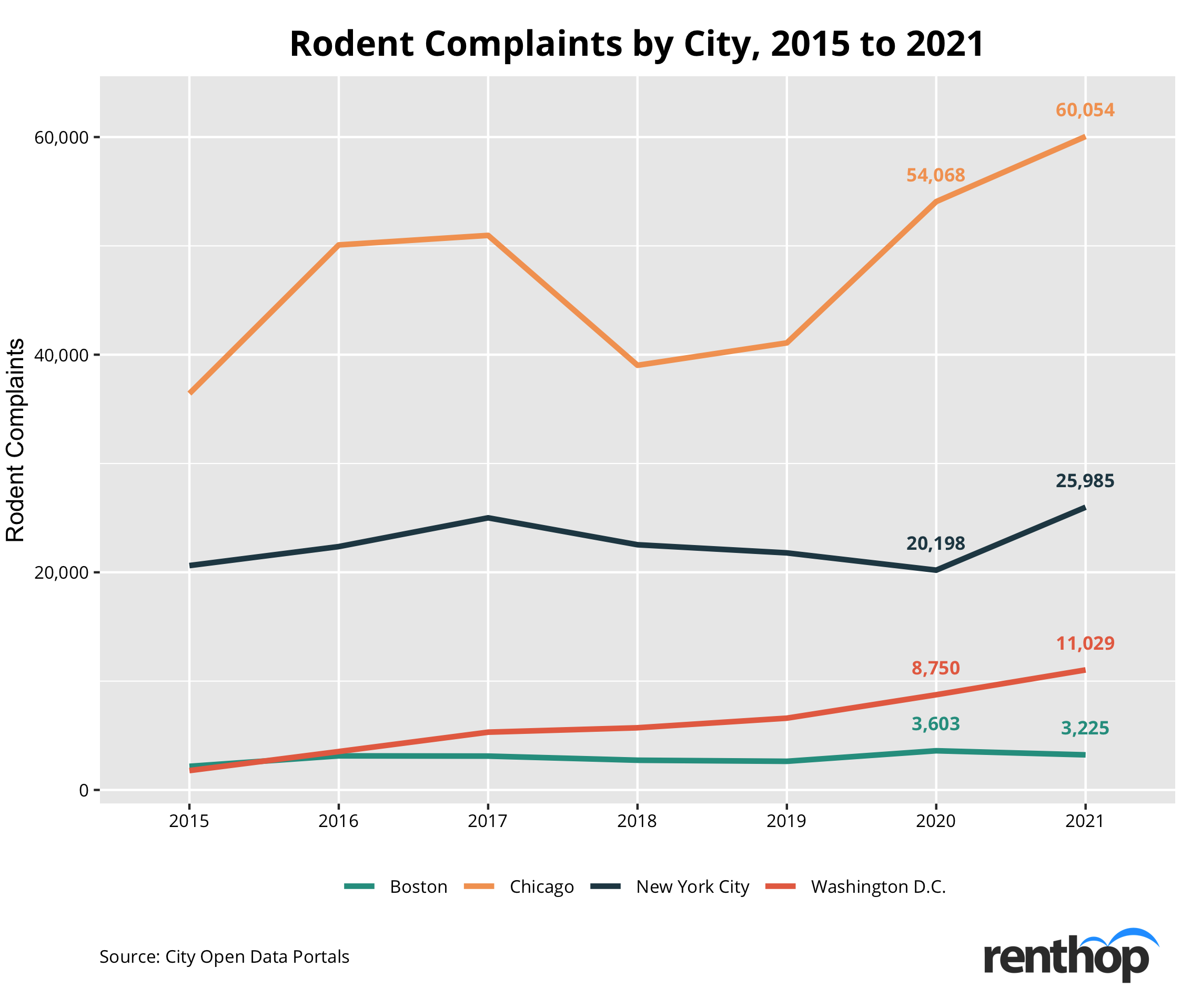One evening, when I was in the restroom of my newly renovated 1830s-era Bay Village apartment, the Boston equivalent of Stuart Little scampered through the nearby kitchen. It stopped about three feet away from me, and paused. As we made eye contact, the little rodent stood up on its back haunches and grasped its front paws together. It seemed as surprised to see me as I was to see it. At the same time, it squeaked and I shrieked. “Stu-aht” dashed away and was never spotted inside again, though my dogs enjoyed tracking its entry point to the defunct fireplace.
For anyone living in cities like New York, Boston, DC, and Chicago, these sightings are not uncommon. In fact, for those living in downtown areas especially, the above-mentioned experience is a minor, almost comical one. We become all too accustomed to seeing rats on the run in the evenings, scampering along curbs and under tires, especially on trash nights, darting from trash bag to trash bag, sampling an avocado peel from a breakfast shop or a scrap of toast from a diner. It’s like Templeton’s festival feast in Charlotte’s Web, but on a regular basis. While this might be fun for the rats, for humans it’s a serious public health concern worth noting.
How bad is the rat problem in Boston, New York, Chicago and Washington D.C.?
Rental listing site RentHop compiles yearly data about rat sightings in the four U.S. cities where rats are most prevalent. The results are even broken down by neighborhood within these four cities, so you can be more informed as you choose your next home.
But first, let’s look at the big picture.
The first graph, seen below, shows the total number of complaints filed for rat sightings in New York, Chicago, Boston, and Washington, DC. over the course of the last six years. In 2021, Chicago reigns as having the most rats (60,054), New York has the second most (25,985), Washington is third (11,029), and Boston is fourth (3,225).

How have rat numbers changed during the pandemic?
Let’s break it down by city, starting with New York. In 2020, reports of rats in NYC dropped a bit, possibly due to an overrun 311 system and residents leaving the city in the wake of the pandemic. In 2021, the reports rose by a staggering 28.7%.
In Washington, the rats are on the rise. The reported sightings have been steadily increasing over the last two years, with a 26% increase in 2021 over 2020 numbers.
In Chicago, where the resident rats hold the largest population in the country, the increase from 2019 to 2020 was significant, and the increase from 2020 to 2021 was slightly slowed, though still a rise of 11.1%.
In Boston, the rats had a slight increase from 2019 to 2020, but surprisingly decreased by 10% from 2020 to 2021.
Which neighborhoods in the U.S. house the most rodents?
Boston
Boston Top 5:
Boston’s 2021 top neighborhoods for rodent neighbors were Downtown (727.4 complaints/sq mi), Bay Village (550 complaints /sq mile), the South End (402.7 complaints /sq mile), the North End (290 complaints /sq mile), and Back Bay (150 complaints /sq mi), in that order.
Boston Greatest Increases and Improvements:
From 2020 to 2021, the neighborhoods which saw the greatest increases in rat sightings were (in descending order): Bay Village (+100%), Mission Hill (+69.7%), South Boston (+38.9%), the South End (+34.8%), and Roxbury (+27.4%).
The neighborhoods with the greatest decreases in rat numbers were: Allston (-56.6%), Seaport (-55.6%), Beacon Hill (-34.8%), Fenway (-33.3%), and the West End (-33.3%).
D.C.
D.C. Top 5:
In Washington, D.C., the top neighborhoods for rats in 2021 were Columbia Heights, Mt. Pleasant, Pleasant Plains, Park View (1,100.6 complaints/sq mi); Shaw, Logan Circle (711.2 complaints/sq mi); Howard University, Le Droit Park, Cardozo/Shaw (623.7 complaints/sq mi); Union Station, Stanton Park, Kingman Park (613.4 complaints/sq mi); and Brightwood Park, Crestwood, Petworth (599.5 complaints/sq mi).
D.C. Greatest Increases and Improvements:
The D.C. neighborhoods which experienced the largest increases in rat population between 2020 and 2021 were: Mayfair, Hillbrook, Mahaning Heights (+100%); Twining, Fairlawn, Randle Highlands, Penn Branch, Fort Davis Park, Fort Dupont (+93.5%); Douglas, Shipley Terrace (+88.9%); Brookland, Brentwood, Langdon (+86.2%); and Georgetown, Burleith/Hillandale (+83.8%).
These D.C. neighborhoods saw the greatest improvement in rat numbers for 2021: Woodland/Fort Stanton, Garfield Heights, Knox Hill (-91.7%); Fairfax Village, Naylor Gardens, Hillcrest, Summit Park (-50%); Cleveland Park, Woodley Park, Massachusetts Avenue Heights, Woodland-Normanstone Terrace (-29.9%); Friendship Heights, American University Park, Tenleytown (-28.6%); and Hawthorne, Barnaby Woods, Chevy Chase (-23.4%).
NYC
NYC Top 5:
In New York City, rats prevailed the most in 2021 in these neighborhoods: Harlem (South), Manhattan (1,586.8 complaints/sq mi); Upper West Side-Manhattan Valley, Manhattan (929.2 complaints/sq mi); Prospect Heights, Brooklyn (821.7 complaints/sq mi); Upper East Side-Yorkville, Manhattan (740.1 complaints/sq mi); and East Village, Manhattan (611.4 complaints/sq mi). How does your neighborhood rank?
NYC Greatest Increases and Improvements:
New York’s biggest increases in rat sightings in 2021 were noted in these neighborhoods: Sheepshead Bay-Manhattan Beach-Gerritsen Beach, Brooklyn (+362%); Prospect Park, Brooklyn (+360%); Kingsbridge-Marble Hill, Bronx (+284.2%); Flatbush (West)-Ditmas Park-Parkville, Brooklyn (+193.2%); Park Slope, Brooklyn (+169.5%); East Elmhurst, Queens (+150%); Upper East Side-Lenox Hill-Roosevelt Island, Manhattan (+147.6%); Brooklyn Heights, Brooklyn (+143.8%); and Crown Heights, Brooklyn (+134.4%).
The New York neighborhoods which successfully decreased their rat populations the most were: Breezy Point-Belle Harbor-Rockaway Park-Broad Channel, Queens (-64%); Kew Gardens Hills, Queens (-52.8%); Borough Park, Brooklyn (-50%); Westchester Square, Bronx (-40.9%); and Gravesend (West), Brooklyn (-37%).
Chicago
Chicago Top 5:
In Chicago, the rat capital of the U.S., the top neighborhoods for total rat numbers were: Clearing (808.8 complaints/sq mi), West Town (723.8 complaints/sq mi), Bridgeport (722.2 complaints/sq mi), Lake View (697.5 complaints/sq mi), and Logan Square (612.7 complaints/sq mi).
Chicago Greatest Increases and Improvements:
Chicago neighborhoods with the largest increases in rat sightings in 2021 were: O’Hare (+271%), Edison Park (+132.6%), West Elsdon (+119.7%), Kenwood (+115.0%), and Oakland (+110%).
The Chicago neighborhoods which successfully decreased their rat populations the most in 2021 were: Douglas (-56.3%), Riverdale (-41.7%), Hegewisch (-27.9%), Morgan Park (-26.5%), and Armour Square (-19.4%).
What are the signs of rats in your home?
Well, there are definitely rats out there, but what are some warning clues that you might be susceptible to rodent visitors?
The top clues are: droppings, rub marks, scratching noises, rat holes, rat nests, and footprints. Droppings tend to be found in concentrated locations, like in drawers or storage boxes. Rub marks come from rats making repeated journeys over the same routes; their body oils and dirt tend to accumulate and make trails. An audible clue: you may hear black rats scratching in attic areas, as they are great climbers; whereas you may hear brown rats grinding their teeth. Brown rats are also known for creating extensive burrow structures, often found with entrances near structures (like the side of a building). Nests, however, may be spotted inside homes, made out of found materials like cardboard or insulation. Finally, want to investigate as a rat detective? Like any animal, rats make footprints. If you suspect a rat, sprinkle some flour on the floor or ground and check the next day for prints.
What can we do about the rat infestation problem?
Now that we know what signs to look for, what are some of the preventative measures we can take to keep the rats out of our homes? The City of Cambridge, MA has compiled a comprehensive guide, found here.
They suggest five main steps that residents can take themselves:
- Look for evidence
- This is self-evident, and includes looking for clues mentioned in the previous paragraph.
- Clean up
- The second step involves washing away track marks and droppings, removing clutter, and trimming greenery close to the home’s exterior.
- Starve them
- The third step necessitates removing garbage (and keeping bins closed tightly), and keeping fresh food securely stored.
- Shut them out
- The fourth step involves sealing off entry points like cracks, holes, and gaps, and closing up burrows.
- Wipe them out.
- The last step is the one that most of us usually jump to, baiting and setting traps.
If all else fails, one could always consider adopting a cat! Seriously, cats do help. But so do professionals. If you’re past step five, it may be time to call in an exterminator or help from the city.
Clearly, rat populations are on the rise. It’s time that we start taking the necessary precautions to keep our homes safe from rodents. However, it will only be successful if we work as a unified community within our own respective neighborhoods. It will have to be a team effort.
Leland is a writer and curator, passionate about the arts and real estate. She especially wants to share clear details about the housing market so that prospective buyers and tenants can make their best-informed decisions.



